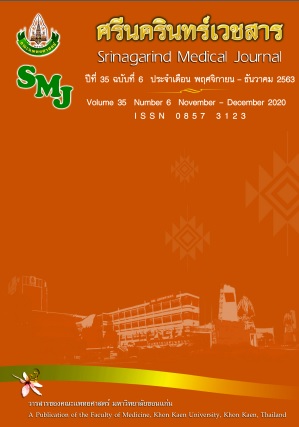Position of Resuscitative Endovascular Balloon Occlusion of the Aorta (REBOA) in Thai People
Abstract
การศึกษาตำแหน่งของการใช้บอลลูนอุดตันเส้นเลือดแดงใหญ่เพื่อห้ามเลือดในการกู้ชีวิตในคนไทย
ภาณุ ธีรตกุลพิศาล, *, ปาริชาติ ตันมิตร, สุภัชชา ประเสริฐเจริญสุข, ไชยยุทธ ธนไพศาล, ณรงชัย ว่องกลกิจศิลป์
ภาควิชาศัลยศาสตร์ คณะแพทยศาสตร์ มหาวิทยาลัยขอนแก่น
Background and Objective: Major cause of trauma death worldwide is from non-compressible torso hemorrhage. Currently, Resuscitative Endovascular Balloon Occlusion of the Aorta (REBOA) plays role in control of intraabdominal bleeding. Therefore, it is necessary to use several methods to confirm the position of the balloon precisely, such as fluoroscopy. But most hospitals in Thailand do not support fluoroscopic machine in ER. This study aimed to determine the intravascular length for placement REBOA and compare to the appropriate locations of external landmarks of the body.
Method: Human cadaveric study, external anatomical (sternal notch, xyphoid process and umbilicus) and intravascular (left subclavian artery (LSA), celiac trunk (CT), lowest renal artery (LRA) and aortic bifurcation (AB)) landmarks from puncture sites. The landing zones were calculated with intravascular landmarks.
Results: Twenty-two cadavers were analyzed. Mean external landmarks from right groin to umbilicus, xyphoid, sternal notchere 19.20, 32.26, 53.42 cm. and from left groin were 19.25, 32.62, 53.65 cm. The mean intravascular distance from right puncture site to AB, LRA, CT, LSA were 21.37, 30.47, 33.95, 55.97 cm. and from left puncture site were 20.69, 29.72, 32.87, 56.20 cm. There are statistically significant of clinical correlations between external and intravascular length of right groin - umbilicus with right puncture site - AB (p=0.0385) and right groin - sternal notch with right puncture site - LSA root (p=0.303).
Conclusion: The use of external anatomical landmarks to estimate length of REBOA in Zone-1 and Zone-3 with evaluate the clinical response is safe to perform the procedure.
Key words: REBOA; Abdominal hemorrhage; Resuscitation; Shock; Trauma
หลักการและวัตถุประสงค์: สาเหตุของการเสียชีวิตจากอุบัติเหตุส่วนใหญ่เกิดจากภาวะเลือดออกในช่องท้อง ในสถานการณ์ปัจจุบัน การใช้บอลลูนอุดตันเส้นเลือดแดงใหญ่เพื่อห้ามเลือดในการกู้ชีวิตมีบทบาทในการห้ามเลือดในช่องท้องและอุ้งเชิงกราน แต่การทำหัตถการนี้จำเป็นต้องใช้เครื่องมือเพื่อยืนยันตำแหน่งที่เหมาะสมของอุปกรณ์ เช่น เครื่องส่องภาพรังสี แต่โรงพยาบาลส่วนใหญ่ในประเทศไทยไม่มีเครื่องมือนี้ที่ห้องฉุกเฉิน จึงเป็นที่มาของการศึกษานี้ เพื่อศึกษาตำแหน่งที่เหมาะสมในการใส่บอลลูนเปรียบเทียบกับอวัยวะภายนอกของร่างกาย
วิธีการศึกษา: ศึกษาจากร่างอาจารย์ใหญ่ โดยศึกษาเปรียบเทียบระยะภายนอก (คอหอย ลิ้นปี่ และสะดือ) และระยะทางภายในหลอดเลือด (หลอดเลือดแดง Subclavian, หลอดเลือดแดง celiac, หลอดเลือดไตซ้าย และจุดแยกของเส้นเลือดแดงใหญ่) กับบริเวณที่แทงเข็มทำหัตถการ (ขาหนีบ)
ผลการศึกษา: จากร่างอาจารย์ใหญ่ 22 ร่าง พบว่า ค่าเฉลี่ยของระยะภายนอกจากขาหนีบขวาไปยังสะดือ ลิ้นปี่และคอหอยเท่ากับ 19.20, 32.26, 53.42 ซม. จากขาหนีบซ้าย เท่ากับ 19.25, 32.62, 53.65 ซม. ระยะทางภายในหลอดเลือดจากขาหนีบขวาไปยังจุดแยกของเส้นเลือดแดงใหญ่ หลอดเลือดไตซ้าย หลอดเลือดแดง celiac และ หลอดเลือดแดง Subclavian เป็น 21.37, 30.47, 33.95, 55.97 ซม. จากข้างซ้ายเป็น 20.69, 29.72, 32.87, 56.20 ซม. โดยมีระยะห่างของอวัยวะภายนอกกับความยาวภายในหลอดเลือดที่มีความสัมพันธ์กันอย่างมีนัยสำคัญทางสถิติ คือ ขาหนีบขวาถึงสะดือกับจุดแยกของเส้นเลือดแดงใหญ่ (p=0.0385) และขาหนีบขวาถึงคอหอยกับหลอดเลือดแดง subclavian (p=0.303)
สรุป: การใช้อวัยวะภายนอกในการประมาณความยาวการใช้บอลลูนอุดตันเส้นเลือดแดงใหญ่เพื่อห้ามเลือดในการกู้ชีวิต ร่วมกับการประเมินการตอบสนองของผู้บาดเจ็บนั้นสามารถทำได้ อย่างไรก็ตามการใช้อวัยวะภายนอกเป็นจุดอ้างอิงตำแหน่งเพียงอย่างเดียวนั้น ต้องทำการศึกษาต่อไป
คำสำคัญ: การตกเลือดในช่องท้อง; การช่วยชีวิต; การช็อก; การบาดเจ็บ


